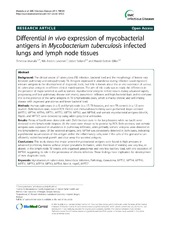| dc.description.abstract | Background: The clinical course of tuberculosis (TB) infection, bacterial load and the morphology of lesions vary between pulmonary and extrapulmonary TB. Antigens expressed in abundance during infection could represent relevant antigens in the development of diagnostic tools, but little is known about the in vivo expression of various M. tuberculosis antigens in different clinical manifestations. The aim of this study was to study the differences in the presence of major secreted as well as somatic mycobacterial antigens in host tissues during advanced rapidly progressing and fatal pulmonary disease with mainly pneumonic infiltrates and high bacterial load, and to compare this to the presence of the same antigens in TB lymphadenitis cases, which is mainly chronic and self-limiting disease with organised granulomas and lower bacterial load. Methods: Human pulmonary (n = 3) and lymph node (n = 17) TB biopsies, and non-TB controls (n = 12) were studied. Ziehl-Neelsen stain, nested PCR 1S6110 and immunohistochemistry were performed. Major secreted (MPT32, MPT44, MPT46, MPT51, MPT53, MPT59, MPT63, and MPT64) and somatic mycobacterial antigens (Mce1A, Hsp65, and MPT57) were detected by using rabbit polyclonal antibodies. Results: Plenty of bacilli were detectable with Ziehl-Neelsen stain in the lung biopsies while no bacilli were detected in the lymph node biopsies. All the cases were shown to be positive by PCR. Both secretory and somatic antigens were expressed in abundance in pulmonary infiltrates, while primarily somatic antigens were detected in the lymphadenitis cases. Of the secreted antigens, only MPT64 was consistently detected in both cases, indicating a preferential accumulation of this antigen within the inflammatory cells, even if the cells of the granuloma can efficiently restrict bacterial growth and clear away the secreted antigens. Conclusions: This study shows that major secreted mycobacterial antigens were found in high amounts in advanced pulmonary lesions without proper granuloma formation, while their level of staining was very low, or absent, in the lymph node TB lesions with organised granulomas and very low bacillary load, with one exception of MPT64, suggesting its role in the persistence of chronic infection. These findings have implication for development of new diagnostic tools. | en_US |

